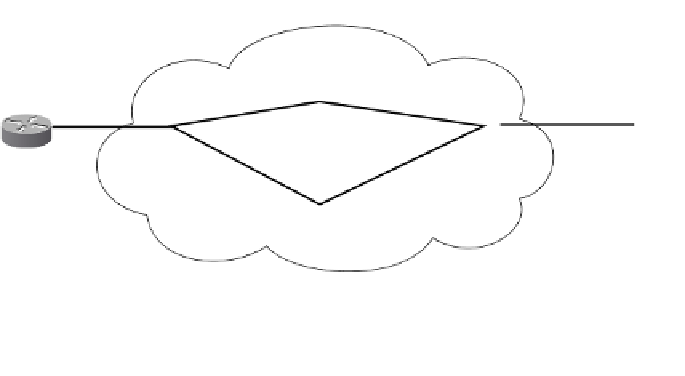Information Technology Reference
In-Depth Information
When an egress LER advertises locally connected routes, it may advertise an Implicit Null
label. This label is received only via the signaling path; it is never received from the
forwarding path. An Implicit Null label directs the penultimate hop LSR to pop the top label
during forwarding.
Figure 10-3 shows a simple example of how label exchange and LSP work. In this example,
all routers are running IS-IS as the IGP to exchange IPv4 routing information. R2 through
R5 are LSRs, and R1 and R6 support only IPv4.
Figure 10-3
Label Distribution and LSP Setup
IP
IP
MPLS
192.168.100.5
192.168.100.6
R3
R1
R2
R5
R6
R4
Upstream
Downstream
All links are Ethernet and have IP addresses assigned from 192.168.0.0/16, with the
corresponding router IDs as the third and fourth octet addresses. For example, the address of
R2 on the link with R4 is 192.168.24.2. All routers have loopback 0 interface addresses
assigned from 192.168.100.x, where
x
is the router ID.
To simplify the discussion, the loopback addresses of R5 and R6 are selected as the prefixes
of interest. Thus, the downstream direction points to R5 and R6. For example, R4 is
considered an upstream LSR to R5.
All LSRs use LDP to exchange label binding information. LSRs use UDP to discover
neighbors. Example 10-3 shows the neighbor discovery of R5 and R2 on R4. The LDP ID
is expressed as a 4-byte router ID (192.168.100.4) and 2-byte label space (0). The label
space defines the range of label values on an LSR. A 0 label space indicates that the labels
are assigned from a single range (global to the platform). In contrast, labels can be inter-
face-specific (where each interface has an independent label range), as in the case of an
ATM interface.
Example 10-3
Output of
show mpls ldp discovery
on R4
R4#show mpls ldp discovery
Local LDP Identifier:
192.168.100.4:0


























